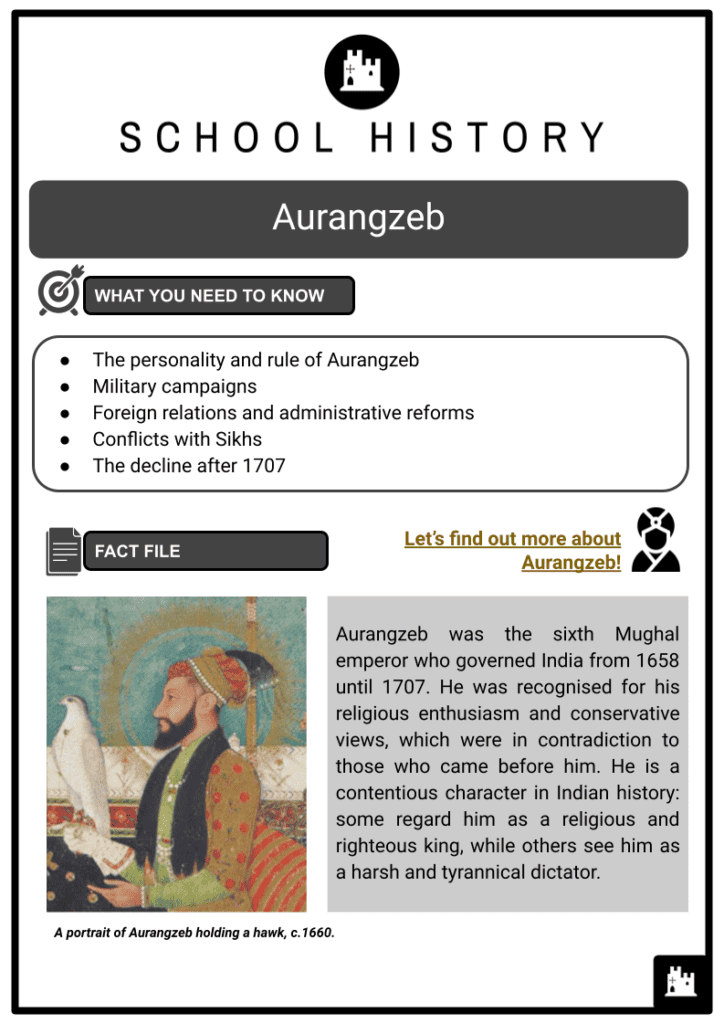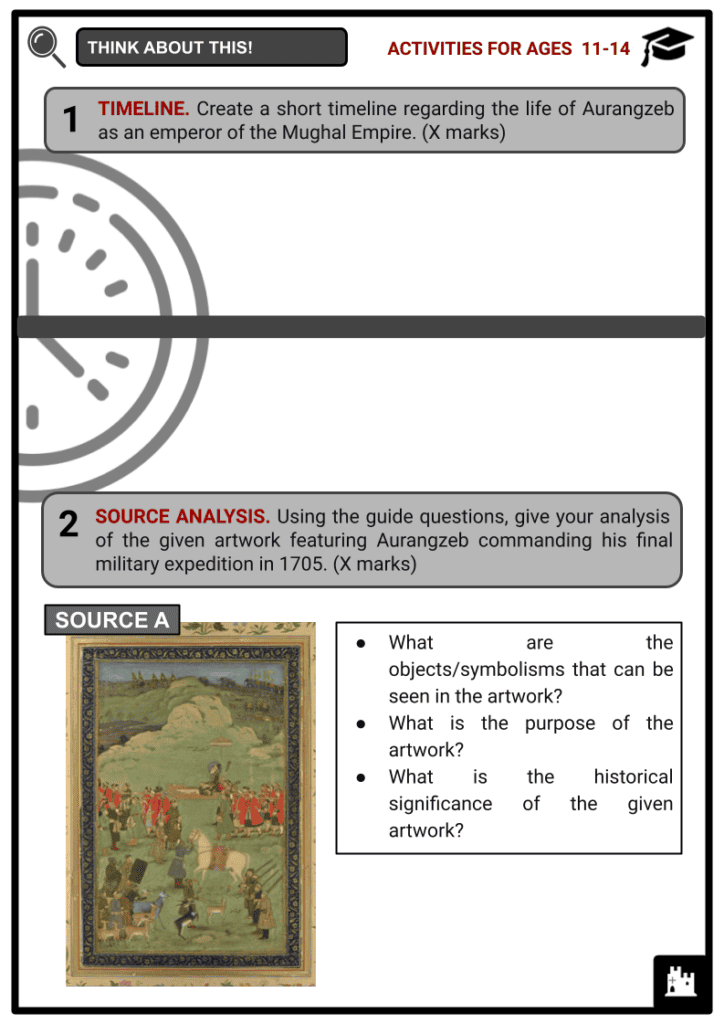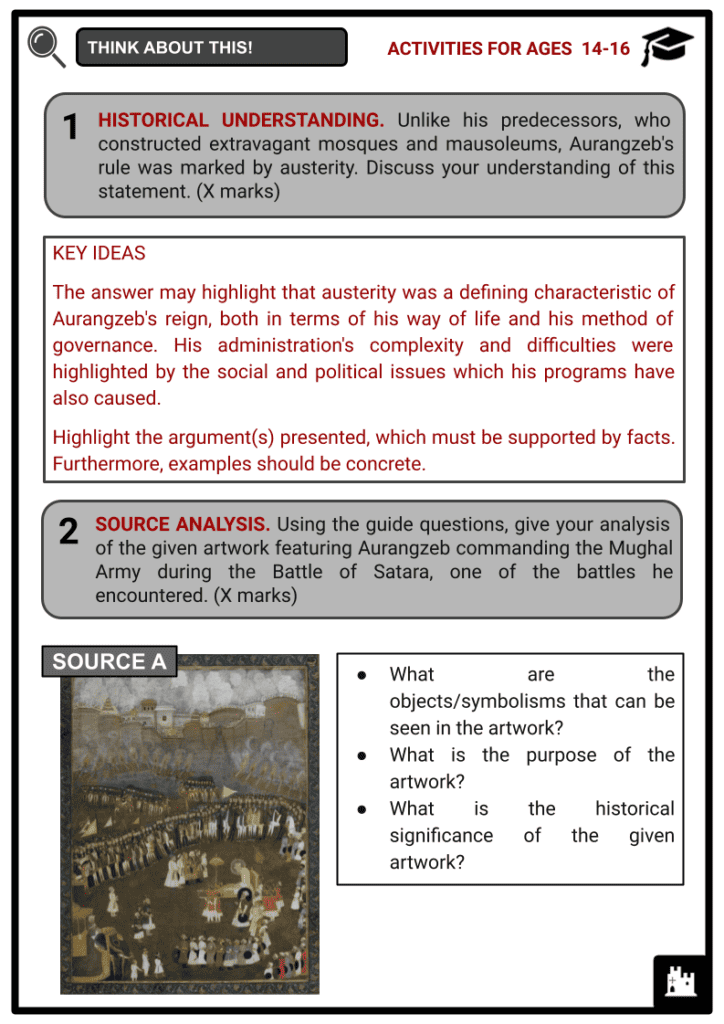Aurangzeb Worksheets
Do you want to save dozens of hours in time? Get your evenings and weekends back? Be able to teach about Aurangzeb to your students?
Our worksheet bundle includes a fact file and printable worksheets and student activities. Perfect for both the classroom and homeschooling!
Summary
- The personality and rule of Aurangzeb
- Military campaigns
- Foreign relations and administrative reforms
- Conflicts with Sikhs
- The decline after 1707
Key Facts And Information
Let’s find out more about Aurangzeb!
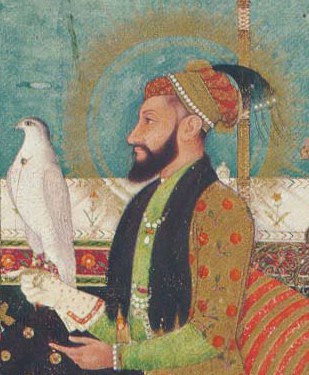
Aurangzeb was the sixth Mughal emperor who governed India from 1658 until 1707. He was recognised for his religious enthusiasm and conservative views, which were in contradiction to those who came before him. He is a contentious character in Indian history: some regard him as a religious and righteous king, while others see him as a harsh and tyrannical dictator.
The personality and rule of Aurangzeb
- By the time Aurangzeb succeeded the Mughal throne, the empire was already showing signs of decline. Gunpowder technology was no longer the superior military weaponry, and corruption was becoming more evident. Prevailing policies that maintained good relations with non-Muslims were revoked. Aurangzeb then imposed Islamic laws on Hindus and had many temples destroyed.
- The third son of Shah Jahan, Aurangzeb was the sixth and last of the great Mughal emperors. Historians suggest that after him, successors grew weaker until they lost power altogether. Aurangzeb gained the throne after the war of succession against his three brothers.
- Unlike his great-grandfather Akbar, Aurangzeb imposed religious intolerance throughout the Mughal Empire. In 1658, a year after he ascended the throne, Aurangzeb appointed muhtasib from the ranks of the clergy or ulema to enforce the imposition of sharia in every large city. Moreover, he prohibited practices against the Muslim faith, including gambling and drinking alcohol.
- Unlike his predecessors who built extravagant mosques and mausoleums, Aurangzeb’s reign was characterised by austerity. He dismissed court musicians that were previously loved during the reign of Shah Jahan. Only the royal band or naubat continued to play music. Ironically, many Persian works on classical Indian music were written during Aurangzeb’s reign.
- Muhtasib, or censors of public morals, were appointed by Aurangzeb to ensure the imposition of Islamic law, or sharia.
- Aurangzeb ordered the compilation of Islamic laws in a book so people could practise the religion correctly. Such laws were organised by hundreds of Muslim scholars from all over the world. They came up with the Fatawa-e-Almgiri, which means ‘The Religious Decrees of Alamgir’.
- All taxes not aligned to Islamic laws were abolished. In order to compensate for the loss in tax revenue, Aurangzeb adopted a simple lifestyle, which was very different to his predecessors. Lavish festivities and royal traditions, including birthdays and weighing of his children, were either abolished or made simpler. Like Hindu temples, Sikh temples, that were also used as political offices, were destroyed.
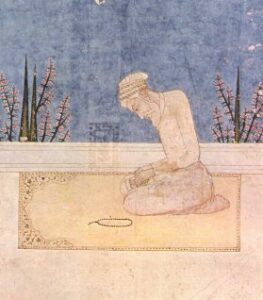
A illustration of an old Aurangzeb in prayer, c.1700. - Aurangzeb was a Sunni Musalman who wanted to convert the country of kafirs, or infidels (India), to a country of Islam. In addition to the Hindus, he also imposed intolerance on Shia Muslims. His policies revolved around the promotion of the tenets of the Muslim faith and the adoption of anti-Hindu measures.
‘Even to look at a temple is a sin for a Musalman’- as stated by Aurangzeb.
- In the first year of his reign, he ordered the demolition of Hindu temples in every province and replaced them with mosques.
- In his 12th year, all famous non-Muslim temples were demolished. In Mewar, about 240 temples were destroyed and replaced with mosques.
- In contrast to Akbar, who abolished tax on Hindus, Aurangzeb imposed them two-fold. This policy financed Aurangzeb’s military campaigns and forced a number of Hindus to convert to Islam. In response, thousands of Hindus protested and Aurangzeb directed his officers to release elephants against the people.
- Initially, Hindu traders were levied with a 5% toll tax, while Muslim traders paid half. Later on, Muslim traders were exempted from such tax.
- Unlike Akbar, who appointed Hindus as government officials, Aurangzeb removed them from these jobs. In 1670, the revenue department banned the employment of Hindus in government offices.
- Hindu educational institutions at Varanasi, Multan and Thatta were destroyed. Moreover, Hindu children were prohibited from studying the basics of Hinduism.
- In addition to the imposition of several types of taxes, Hindus who converted to Islam were given jobs. Hindu prisoners who changed their faith were promised freedom.
- Despite allowing the celebrations of Holi and Diwali festivals, Hindus were restricted from wearing fine clothes. No Hindu, except Rajputs, were allowed to ride an elephant or a horse. Cremation of their dead on the banks of the rivers Sabarmati and Yamuna was also banned.
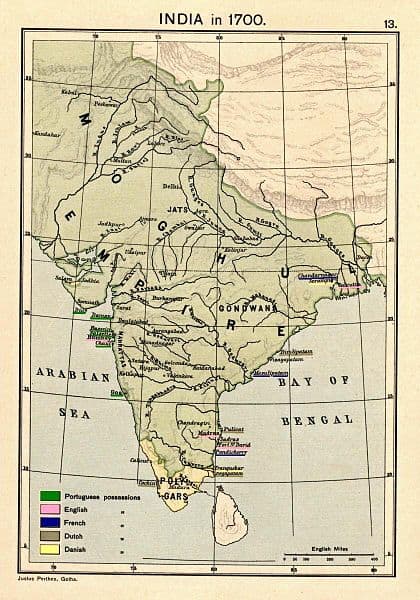
The map of the Mughal Empire under Aurangzeb, c.1700.
IMPACT OF AURANGZEB’S POLICIES
-
- Conflict with the Jats, Satnamos, Sikhs, Marathas and the Rajputs emerged. Such rebellions interrupted the peace of the empire.
- The empire’s administrative, economic and military structure weakened.
- Aurangzeb’s fanaticism clouded his virtues.
- Extravagant royal ceremonies were lessened, therefore diminishing imperial spending.
- Aurangzeb’s term was defined by his stringent execution of Islamic law and his endeavours to promote the dominant position of Islam throughout India. He reinstated the jizya tax on non-Muslims and barred the construction of new temples and the maintenance of old ones. He also removed the role of the main Hindu religious leader and replaced it with a Muslim Qazi.
- Aurangzeb’s policies were greeted with resentment from many Hindus and Sikhs, who regarded him as a danger to their religious freedom and one’s cultural identity. This led to various rebellions and uprisings throughout his rule, notably the Maharatha insurrection and the Sikh revolt.
- Aurangzeb’s policies also had a detrimental influence on the Mughal economy, as the prohibition on temples led to a drop in the need for trained labour and the jizya tax led to a decline in commerce with non-Muslim countries.
Military campaigns
- During the time of Aurangzeb, the Maratha Empire was steadily rising as a force in India. The Marathas were a Hindu military group that the Mughals had previously repressed. However, under Shivaji’s leadership, they had created an independent kingdom in western India.
- Aurangzeb was keen to bring the Marathas under Mughal authority and undertook multiple campaigns against them. However, the Marathas proved to be a formidable opponent, and despite constant setbacks, they were able to mount a counteroffensive and reclaim control of their territory.
MUGHAL-MARATHA WARS
- In September 1681, Aurangzeb began his journey to conquer the small Maratha Empire, which sheltered his rebel son Sultan Muhammad Akbar.
- With about 500,000 Mughal contingents, Aurangzeb made the Deccan his capital. By December of the same year, Aurangzeb ordered the first Mughal attacks on Janjira and Northern Konkan.
- After failed attempts, Aurangzeb moved to Ahmednagar in late 1683 where he divided his force into two, headed by his two sons, Shah Alam and Azam Shah. These divisions planned to attack the Marathas from the north and south.
- In 1674, Shivaji made his way back to the Deccan and proclaimed himself Chhatrapati, or king of the Maratha Kingdom.
- In 1684, Shahabuddin Khan, one of Aurangzeb’s generals, attacked Raigad, the Maratha capital. However, Maratha commanders were able to defend their city and defeat the contingent sent by Aurangzeb in the Battle at Patadi.
- For the second time in early 1685, Shah Alam led a failed attack against the Marathas from the south. In April, in response to consecutive defeats, Aurangzeb changed his strategy.
- By September 1686, Aurangzeb broke his treaties with Golconda and Bijapur (both allies of Marathas) and conquered them.
- The fall of the kingdoms of Golconda and Bijapur to the Mughals, and the capture and later execution of Sambhaji, Chhatrapati Shivaji’s eldest son, weakened the Marathas.
- With the death of Sambhaji, his brother, Rajaram, gained the title Emperor. In March 1690, Maratha forces attacked the Mughal army, killing Aurangzeb’s private force. In the south, the Marathas were able to defend fort Panhala against the Mughals. As advised, Rajaram escaped to Jinji. Aurangzeb then changed his plans, and finally captured Jinji, but incurred heavy Mughal losses in the process.
IMPACT OF THE MUGHAL CAMPAIGN AGAINST THE MARATHAS
-
- The Maratha Confederacy dissolved into warring fragments.
- Amid the victory of Aurangzeb, Maratha bands challenged the authority whenever opportunity arose.
- The Mughal Empire expanded south to more than 3.2 million square kilometres.
- Great Maratha leader Sambhaji was captured and executed in December 1688 after refusing to convert to Islam.
- In 1706, Aurangzeb exhausted himself and his army with the war against the Marathas. The Marathas largely contributed to the decline of the empire in the coming years.
- A mix of political, military and religious concerns prompted Aurangzeb’s decision to relocate the capital to Aurangabad in the Deccan.
- By shifting his capital to the Deccan, Aurangzeb intended to be closer to the fight and better equipped to cope with the Marathas.
- He was also confronting rebellions and uprisings in several regions of northern India. Transferring the capital to the Deccan allowed him to separate himself from these conflicts and manage the empire from a safer location.
- He was also interested in establishing Mughal rule over the Deccan Sultanates of Bijapur and Golconda. By shifting his capital to the area, he was better able to watch over these sultanates and quickly establish attacks against them.
- He was concerned with propagating Islam in the region. The Deccan had a substantial Muslim population, and by transferring the capital there, Aurangzeb wanted to promote the faith and challenge the power of the Hindu Marathas.
Foreign relations and administrative reforms
- Both military conquests and diplomatic alliances marked Aurangzeb’s foreign policy, as he strove to increase Mughal authority and safeguard the empire from external dangers. He conducted a number of military operations to conquer new territory, including operations in the Deccan. Aurangzeb also conducted expeditions in Afghanistan, Central Asia, and the northwest boundary of India. These battles were effective in extending the empire’s territory, but they also resulted in a tremendous strain on resources and led to the final downfall of the Mughal Empire.
- Aurangzeb’s foreign policy was not restricted to military wars. He also participated in diplomacy and forged ties with foreign nations. For example, he maintained close connections with the Safavid dynasty of Iran and participated in exchanging diplomatic envoys with them. He also forged partnerships with various Central Asian tribes to secure the empire’s northern boundary.
- Aurangzeb considered the East India Company a danger to Mughal rule and sovereignty. He was particularly concerned about the company’s developing military strength and the possibility for them to challenge Mughal authority. As a result, he started putting limitations on their actions and tried to reduce their influence.
- One of the significant disputes between Aurangzeb and the East India Company happened in 1686. Aurangzeb issued a prohibition on the export of saltpetre, an essential component in gunpowder, in an effort to curtail the company’s military capabilities. The British replied by smuggling saltpetre out of India, resulting in an economic dispute between the two sides.
- Aurangzeb also considered the East India Company as a religious risk. He was a devoted Muslim who thought expanding Islam beyond the empire was crucial. He was afraid that the company’s operations may lead to the growth of Christianity in India, and he wanted to limit the impact they had as a result.
- Aurangzeb established a number of critical changes that had a long-lasting effect on the administration and economics of the empire. He was renowned for his reforms and his efforts to enhance the revenue of the Mughal Empire.
- The zabt system was one of Aurangzeb’s administrative innovations. Under this system, the land was evaluated and a set revenue was levied on each piece of land. The former method of income collection, which was based on a portion of the produce, was replaced with this one. This system was aimed to provide a stable source of income for the empire and combat corruption when collecting revenue.
- Establishing the jagirdari system involved giving military officers land grants called jagirs in exchange for their services. They were also tasked with maintaining law and order in their region. This system assisted in preserving the Mughal Empire’s military might and ensured the military officers’ loyalty.
- Aurangzeb also introduced policies to increase the production of cash crops like indigo and opium, which were significant sources of income for the empire. Taxes were also levied on non-Muslims, such as jizya and the pilgrim tax, which was imposed on Hindus visiting holy sites.
- The administrative changes and revenue-generating initiatives of Aurangzeb significantly impacted the Mughal Empire. These reforms, such as increasing taxes, however, also had drawbacks, which in the long run resulted in social discontent and economic downfall.
Conflicts with Sikhs
- Late in the 17th century, Aurangzeb’s dispute with the Sikh community started, and it persisted throughout his reign. A number of Muslim leaders, including Aurangzeb, saw the Sikh community, which was based in the Punjab region and had been expanding in size and influence, as a threat to their religious beliefs and practices.
- When Aurangzeb ordered the death of leader Guru Tegh Bahadur, the ninth Sikh leader, their battle with the Sikhs took off in 1675. The guru was regarded as a threat to Aurangzeb’s power since he refused to convert to Islam.
- The Sikh community came together in support of Guru Tegh Bahadur’s son, Guru Gobind Singh, following his execution. Guru Gobind Singh was a charismatic leader. In order to fight the Mughal armies in the Punjab region, the Sikhs started to form a military organisation known as the Khalsa.
- The Sikh insurrection was met by violent suppression under Aurangzeb. He levied high tariffs on Sikh communities and gave the go-ahead for the detention and killing of Sikh leaders. The Sikhs still persisted in defying Mughal rule, and their actions did little except escalate the war.
- Until his passing in 1707, Aurangzeb and the Sikhs were at odds. In spite of his attempts, the Sikh community grew and prospered, and in the early 19th century they finally founded their own independent state in the Punjab area.
- Overall, Aurangzeb’s struggle with the Sikhs was a crucial turning point in Indian history. It brought conflicts between many religious groups in the area and showed the Mughal Empire’s struggles in controlling such a varied and intricate population. The struggle also had long-term effects since it helped the Sikh community expand and ultimately paved the way for the creation of an independent Sikh state.
The decline after 1707
- The collapse of the Mughal Empire began with Aurangzeb’s death in 1707. The latter Mughal emperors were incompetent and feeble, and as local and regional leaders rose to prominence, the empire was more divided. The empire became vulnerable to outside incursions as a result of its weakness and division.
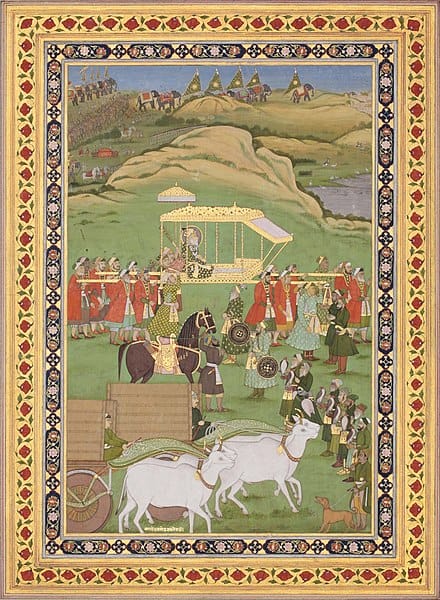
An illustration of an old Aurangzeb hunting with hounds and falconers, c.18th century. - The death of Aurangzeb was followed by a war of succession among his three sons. Prince Muazzam, the eldest son, won and ascended the throne under the name Bahadur Shah.
- After 49 years of ruling about 150 million people and expanding the empire to its greatest extent, Aurangzeb’s power came to an end. Aurangzeb’s body was buried in a simple grave within a Sufi shrine in Khuldabad, Maharashtra. This was in contrast to the lavish tombstones of his predecessors.
Aurangzeb was remembered in India in the following ways:
-
- During his reign, the empire acquired enormous wealth that other empires could not match.
- The greatest territorial expansion was seen under his rule. Its population outstripped the entirety of Europe.
- Under his rule, the number of European travellers and traders crossing to India increased. Traders from Britain, Portugal and France established operations and established trade agreements with the Mughals.
- Upon his death, the Mughal Empire was on the verge of rebellion. Azam, governor of Gujarat, proclaimed himself emperor, while Kam Baksh, governor of the Deccan, conquered Gulbarga and Hyderabad. By 1707–08, Muazzam, governor of Kabul, defeated his brothers and ascended the throne. With the title ‘Bahadur Shah’, Muazzam attempted to reconcile with the Rajputs, the Marathas, the Bundelas, the Jats and the Sikhs.
- Bahadur Shah I, also known as Shah Alam I, was referred to by many scholars as the first and the last of the later Mughal emperors to exercise real authority.
- In order to ensure the survival of the empire, Jahandar Shah (son of Bahadur Shah) employed friendly policies towards the Rajputs, Marathas and Hindus. Among the pro-Hindu policies were:
- Abolition of jizyah
- Appointment of Jai Singh of Amber as governor of Malwa
- Ajit Singh of Marwar was made governor of Gujarat, with the title ‘Maharaj’
- By 1738, the bankrupt Persian Empire invaded the weak Mughal Empire. At Karnal in 1739, the Mughals faced defeat. The emperor was taken prisoner. Persian ruler Nadir Shah plundered the royal treasury. A number of emperors succeeded the throne and the Mughal Empire faced its end with the coming of the British in 1857.
- In 1738, with a sizable force, Nadir Shah invaded India in an effort to steal the Mughal Empire’s immense assets. Muhammad Shah, the Mughal emperor at the time, was unable to fend off the invasion successfully, and Nadir Shah was able to take control of and plunder Delhi, the Mughal capital.
- During Nadir Shah’s invasion, the Battle of Karnal occurred. The conflict was fought between the Mughal armies and the Persians, with the latter emerging victorious. Nadir Shah captured the Mughal emperor, and the Mughal armies suffered significant losses.
- One of the outcomes of Nadir Shah’s invasion was the Sack of Delhi in 1739. The famed Peacock Throne, which served as a symbol of Mughal authority and luxury, was among the immense sums of gold that Nadir Shah took with him when he pillaged Delhi. The Sack of Delhi signalled the beginning of the end for the Mughal Empire by causing the loss of much of its riches and prestige.
- The Mughal Empire’s decline was mostly caused by the loss of territory after Aurangzeb’s death and Nadir Shah’s invasion. The weaker Mughal Empire was unable to fend off foreign incursions effectively, and the loss of riches and prestige caused the empire to disintegrate and finally fall.

